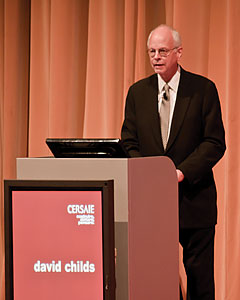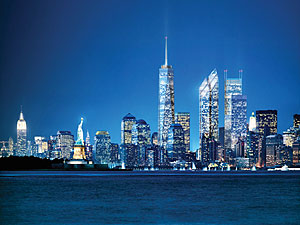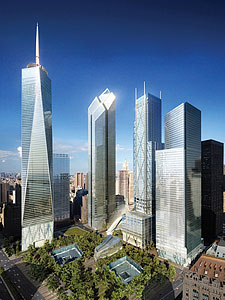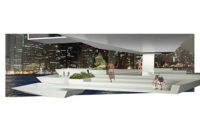
Much of Childs’ presentation was on the plans for
Ground Zero, specifically 1 World Trade Center (formerly named the Freedom
Tower).
This past September, architect David Childs held an intimate Q & A session with members of the press attending the Cersaie 2010 exhibition of ceramic tile and bathroom furnishings in Bologna, Italy. Much of the focus was on his plans for Ground Zero, specifically 1 World Trade Center (formerly named the Freedom Tower). Following the press conference, Childs gave a keynote lecture that included a more detailed presentation on the subject.

David Childs, Chairman Emeritus of Skidmore, Owings
& Merrill (SOM) in New York, spoke at the Cersaie 2010 exhibition of
ceramic tile and bathroom furnishings in Bologna, Italy, which took place in
September.
• National Geographic Headquarters (Washington, DC)
• U.S. News and World Report Headquarters (Washington, DC)
• The 1976 Washington Mall master plans and Constitution Gardens (Washington, DC)
• Time Warner Headquarters at Columbus Circle (New York, NY)
• Bear Stearns (now J.P. Morgan) headquarters (New York, NY)
• The master plan in Riverside South

The exterior facade of 1 World Trade Center (pictured
in the center) will be glass, and the corners of the structure will be tapered
rather than going straight from the bottom to the top. Photo Credit: dbox, courtesy of Silverstein Properties
After the towers actually did fall, this presented Childs with some insight on how new structures should be built, and it also revealed to him how architecture has changed for the better since the original World Trade Center construction in 1965.

Like the original Twin Towers, 1 World Trade Center
(pictured on the far left) will measure approximately 1,360 feet high. With an
antenna to transfer communication, the structure will reach 1,776 feet high -
symbolizing the year the U.S. declared its independence. Photo Credit: dbox, courtesy of Silverstein Properties
Q & A session
When asked about how he felt being faced with such a difficult project, Childs said that while “every project presents a new opportunity and a white sheet of paper,” there were a range of other factors involved. “Dealing with Ground Zero, something emotional, it becomes a critical moment,” he said. “The world is watching for your response.”Childs went on say that he believes in individuals working with others to achieve more, and that this project certainly required more than just his planning. “Larry Silverstein, the client, thought I should do everything, but one of my conditions was to not do a repeat of the 1965 building, which was done by a single hand,” he said.
“We’re doing such a better job today as opposed to the original building in 1965,” Childs continued. “There’s a concern for how people live, culture, how pedestrians will view the new structure, how environmentally it’s affecting everyone, etc.”
During the discussion, a question was raised regarding whether or not it was correct to say that Childs is designing a piece of New York City and not just a building. “Today, many architects are concerned with how to create a solution for the planet,” said the architect. “Aesthetics are still important, just like a chair should look nice, but it should also be comfortable. With past architecture, the result was often uncomfortable and scale-less. I feel strongly that in many cases today, architects want to make great places - tying in culture, comfort, the environment, etc.”

The lobby (this picture and the next) at 1 World Trade Center will have multiple layers, and it will serve
as an area for displays of artwork. Early renderings of the project have
depicted the use of a white-colored marble for the lobby as well as below-grade
public space, which would provide a neutral backdrop for the artwork. Photo Credit: SPI, SOM, courtesy of Silverstein Properties
Childs went on to say that the building will feature a water recycling system, sustainable energy use and sustainable materials, including stone and tile. The project has been ongoing for 10 years, and Childs explained that support has grown as time has progressed. “A good architect listens,” he said. “I knew everyone would have an opinion. Many said what I was doing was terrible, and I should leave the space empty. I didn’t agree. As time has evolved, these feelings have been recessed. Now, many feel this is a sign of resilience and honor to those who worked there.”

A more in-depth look
Before a larger audience, Childs continued his discussion of 1 World Trade Center with a presentation of his technical plans for the project. Much of the design focuses on sustainability and safety, while also providing a quality space for its tenants and visitors. “I wanted a sense of openness and light,” said Childs.The building’s exterior facade will be glass, and the corners of the structure will be tapered rather than going straight from the bottom to top - allowing for more sunlight at any floor. The glass pieces for the facade will be installed as a curtain wall system to create a sense of “solidness.” Additionally, mechanical systems along the glass walls will allow fresh air to enter the building.
Meanwhile, the lobby at 1 World Trade Center will have multiple layers, and it will serve as an area for displays of artwork. Early renderings of the project have depicted the use of a white-colored marble for the lobby as well as below-grade public space, which would provide a neutral backdrop for the artwork.
Like the original Twin Towers, 1 World Trade Center will measure approximately 1,360 feet high, and with an antenna to transfer communication, the structure will reach 1,776 feet high - symbolizing the year the U.S. declared its independence. For Childs, the antenna represents freedom.
Regarding safety, Childs noted that the building will have triple-wide staircases and fire-proof elevators, among other elements. At the time of his presentation, construction for 1 World Trade Center was at 20 floors high.

